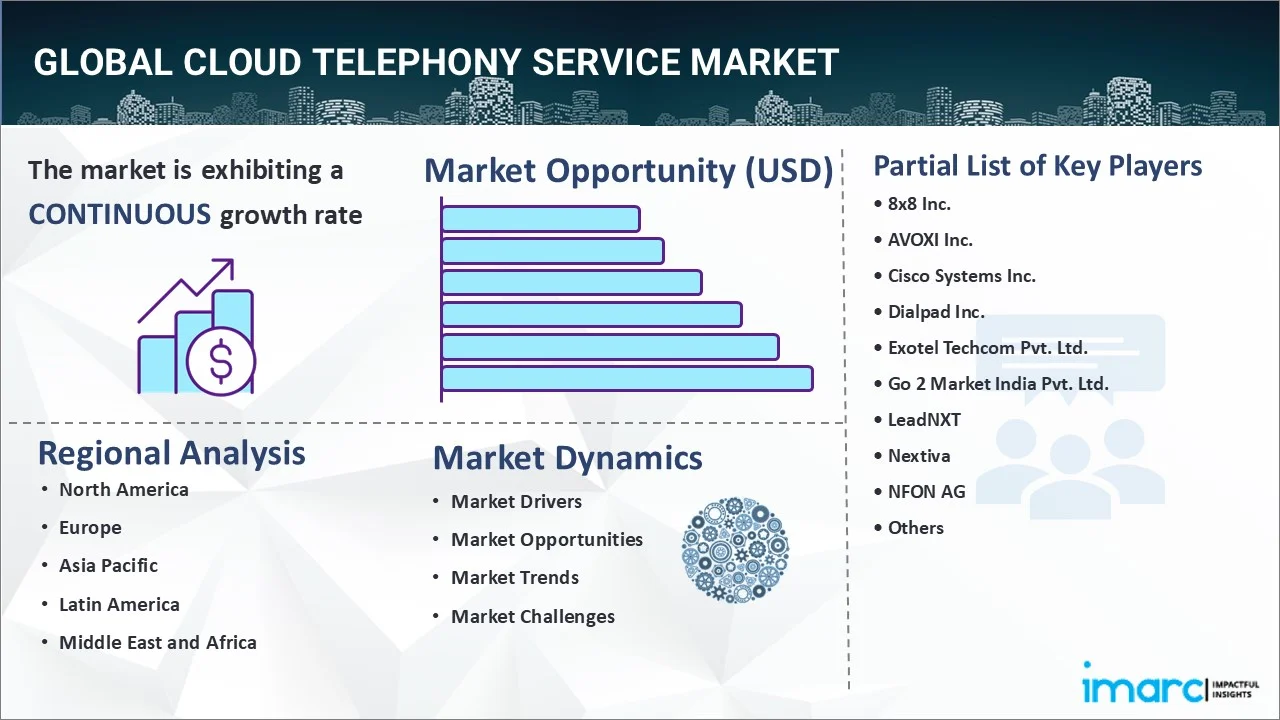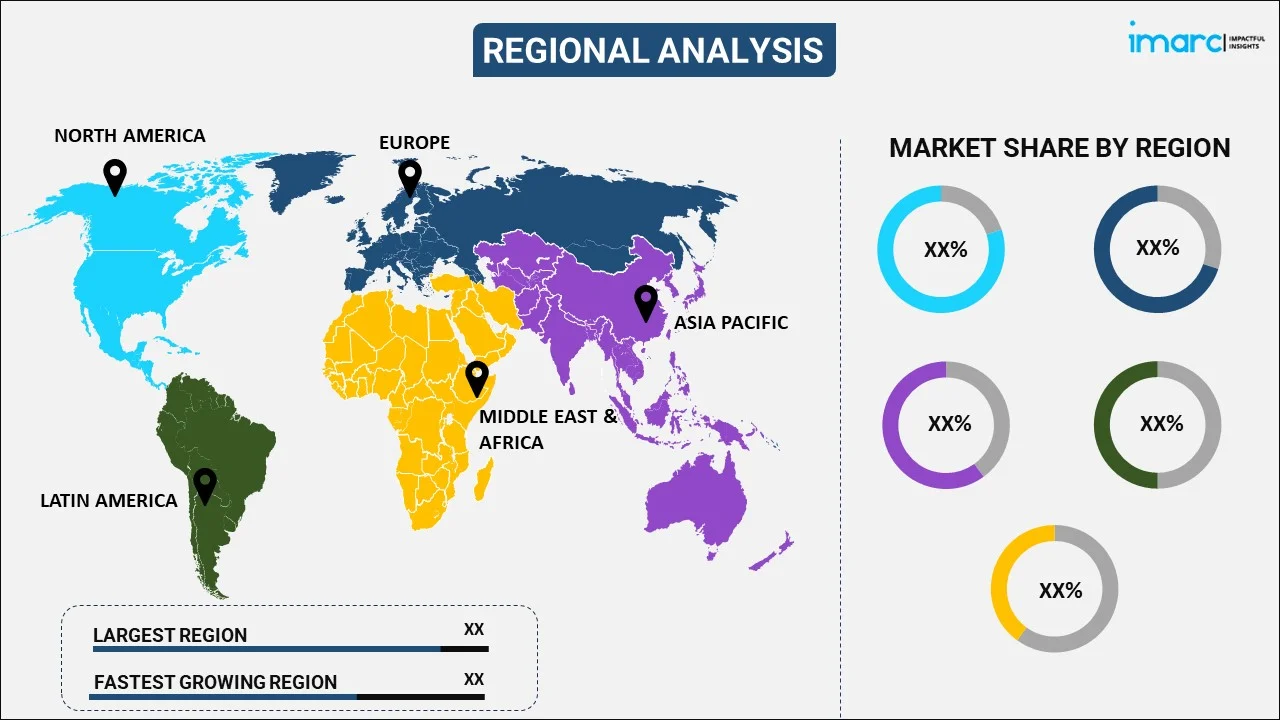
Cloud Telephony Service Market by Network (Public Switched Telephone Networks (PSTNs), Voice Over Internet Protocol (VoIP)), Deployment Mode (Cloud, Hosted), Enterprise Size (Small and Medium-Sized Enterprises (SMEs), Large Enterprises), Application (Conferencing, Multi-level IVR, Sales and Marketing, Customer Relationship Management (CRM)), End User (BFSI, Government, Telecom and IT, Healthcare, Media and Entertainment, Retail, and Others), and Region 2025-2033
Market Overview:
The global cloud telephony service market size reached USD 23.9 Billion in 2024. Looking forward, IMARC Group expects the market to reach USD 47.8 Billion by 2033, exhibiting a growth rate (CAGR) of 7.99% during 2025-2033. The increasing usage in call centers, rising number of schools and applicants, and the growing travel and tourism (T&T) activities are some of the major factors propelling the market.
|
Report Attribute
|
Key Statistics
|
|---|---|
|
Base Year
|
2024 |
|
Forecast Years
|
2025-2033
|
|
Historical Years
|
2019-2024
|
| Market Size in 2024 | USD 23.9 Billion |
| Market Forecast in 2033 | USD 47.8 Billion |
| Market Growth Rate (2025-2033) |
7.99%
|
Cloud telephony service relies on the telecommunications technology for allowing businesses or individuals to make and receive phone calls over the internet, using cloud-based servers rather than traditional telephone lines or on-premises hardware. It reduces the complexity and costs of maintaining conventional phone networks. It offers scalability, as businesses can easily add or remove phone lines and adjust their capacity according to their needs. It provides flexibility by enabling users to make and receive calls from any internet-connected device, such as smartphones, tablets, laptops, or IP desk phones.

The increasing demand for cloud telephony services in small and medium enterprises (SMEs) on account of their numerous advantages, such as scalability, flexibility, and cost effectiveness, is fueling the growth of the market. Moreover, the rising usage of cloud telephony services in call centers to provide features like automatic call distribution, call queuing, and call recording for enhancing efficiency, improving call handling, and enabling better customer interactions is favoring the growth of the market. In addition, there is an increase in the adoption of cloud telephony services in the education sector for admissions, student services, and remote learning. This, coupled with the growing number of schools and the rising number of applicants, is influencing the market positively. Apart from this, cloud telephony services are employed in the hospitality and travel industry for managing reservations, guest inquiries, and customer support. This, along with burgeoning travel and tourism (T&T) due to rapid urbanization and inflating income levels, is strengthening the growth of the market.
Cloud Telephony Service Market Trends/Drivers:
Increasing inclination towards remote working solutions catalyzing the demand for cloud telephony service
The rising adoption of remote working policies represent one of the major factors driving the demand for cloud telephony services around the world. Cloud telephony services allow employees to access their business phone system from anywhere with an internet connection, which enables seamless communication regardless of their physical location. These services enhance productivity, support remote collaboration, and ensure that employees can stay connected with customers and colleagues even when working remotely or on the go.
Rising number of collaborations among service providers stimulating market growth
For businesses looking to expand their operations globally, traditional telephony systems generally face challenges when establishing a presence in international markets, such as obtaining local phone numbers, dealing with complex regulations, and managing multiple service providers. As a result, cloud telephony service providers are collaboration with different players to offer virtual phone numbers from various countries and enable businesses to establish a local presence without physical infrastructure. They are also eliminating geographical barriers, facilitating international growth and enabling businesses to scale their operations efficiently on a global scale.
Rapid deployment and easy management driving demand for cloud telephony service
The quick deployment and easy management of cloud telephony services to provide a hassle free communication solution is influencing the market positively. It involves minimal setup and configuration, which allows businesses to run swiftly. It provides intuitive management interfaces, which enable businesses to manage phone lines, extensions, and features easily. As a result, the ease of deployment and management is allowing businesses to focus on their core operations.
Cloud Telephony Service Industry Segmentation:
IMARC Group provides an analysis of the key trends in each segment of the global cloud telephony service market report, along with forecasts at the global, regional and country levels from 2025-2033. Our report has categorized the market based on network, deployment mode, enterprise size, application, and end user.
Breakup by Network:

- Public Switched Telephone Networks (PSTNs)
- Voice over Internet Protocol (VoIP)
Voice over internet protocol (VoIP) represents the commonly used network of the cloud telephony service
The report has provided a detailed breakup and analysis of the cloud telephony service market based on the network. This includes public switched telephone networks (PSTNs) and voice over internet protocol (VoIP). According to the report, voice over internet protocol (VoIP) represented the largest segment. Cloud telephony service relies on voice over internet protocol (VoIP) network to transmit voice data packets over the internet. Its providers handle the conversion between digital and analog signals, which ensures seamless communication between VoIP-based cloud systems and traditional PSTN networks. VoIP offers numerous advantages, including cost savings, flexibility, scalability, and integration capabilities. It allows businesses to leverage the internet for their voice communication needs, which enables features, such as call forwarding, virtual phone numbers, voicemail-to-email, and integration with other applications like CRM systems.
Cloud telephony service is associated with public switched telephone networks (PSTNs), which is the traditional circuit-switched telephone network that has been in use for many years. PSTNs rely on copper wires and physical connections to establish voice communication. They consist of various interconnected telecommunication networks operated by multiple service providers globally. They support both voice and data transmission and are regulated by telecommunication authorities.
Breakup by Deployment Mode:
- Cloud
- Hosted
Cloud dominates overall market
The report has provided a detailed breakup and analysis of the cloud telephony service market based on the deployment mode. This includes cloud and hosted. According to the report, cloud represented the largest segment. Cloud-based cloud telephony service is hosted and managed by a third-party service provider, which maintains the hardware, software, and network infrastructure required for the telephony service. It can be accessed through the internet, typically using web-based portals or dedicated applications provided by the service provider.
The hosted deployment model allows businesses or individuals to have more control over their telephony system while still leveraging the benefits of a cloud-based service. It has specific requirements or preferences that necessitate maintaining certain equipment on-site. It is often chosen by businesses that want to integrate their existing infrastructure with the hosted telephony service or need more customization options.
Breakup by Enterprise Size:
- Small and Medium-Sized Enterprises (SMEs)
- Large Enterprises
Cloud telephony service is widely used in large enterprises
The report has provided a detailed breakup and analysis of the cloud telephony service market based on the enterprise size. This includes small and medium-sized enterprises (SMEs) and large enterprises. According to the report, large enterprises represented the largest segment. Large enterprises opt for cloud telephony service for greater control, customization, and integration with their existing systems. They can tailor the cloud telephony service to meet their specific needs, which ensures high levels of security and compliance.
Cloud telephony service is used in small and medium sized enterprises (SMEs)to eliminate the need for upfront investments in hardware, software, and maintenance. SMEs can subscribe to a cloud telephony service on a pay-as-you-go basis, which reduces the financial burden associated with traditional on-premises telephony systems. SMEs can focus on their core business operations without the need for technical expertise or dedicated IT staff to manage telephony systems. It frees up resources and allows the organization to focus on growth and strategic initiatives.
Breakup by Application:
- Conferencing
- Multi-level IVR
- Sales and Marketing
- Customer Relationship Management (CRM)
Cloud telephony service finds extensive application in customer relationship management (CRM)
The report has provided a detailed breakup and analysis of the cloud telephony service market based on the application. This includes conferencing, multi-level IVR, sales and marketing, and customer relationship management (CRM). According to the report, customer relationship management (CRM) accounted for the largest market share. Cloud telephony service integrates seamlessly with customer relationship management (CRM) systems to improve customer interactions and streamline workflows. The integration allows the automatic logging of call details, call recording attachments, and call outcome updates within the CRM. It facilitates a holistic view of customer interactions, enables personalized customer service, and provides valuable data for sales and marketing teams. It assists in enhancing efficiency, collaboration, and customer satisfaction.
Cloud telephony service offers seamless and cost effective conferencing solutions. It allows multiple participants to join audio or video conferences from different locations using their internet connected devices. Its providers often offer features, such as call recording, screen sharing, chat, and participant management. It is useful for businesses conducting remote meetings, webinars, training sessions, or virtual collaborations to facilitate effective communication and collaboration regardless of geographical barriers.
Breakup by End User:
- BFSI
- Government
- Telecom and IT
- Healthcare
- Media and Entertainment
- Retail
- Others
BFSI holds the biggest market share
The report has provided a detailed breakup and analysis of the cloud telephony service market based on the end user. This includes BFSI, government, telecom and IT, healthcare, media and entertainment, retail, and others. According to the report, BFSI represented the largest segment. Cloud telephony service is employed in the BFSI sector to offer efficient customer support, streamline communication, and secure transactions. It allows banks, insurance companies, and financial institutions to provide automated IVR systems for account inquiries, payment reminders, and customer self-service options. It also facilitates call recording and compliance adherence for regulatory purposes, ensuring data security and privacy.
Government agencies can also benefit from cloud telephony service by enhancing citizen services and internal communications. It enables automated helplines, emergency response systems, and interactive voice-based information services. It is also used for virtual meetings, public announcements, and feedback collection.
There is a rise in the use of cloud telephony service in the telecom and IT industry to improve the communication infrastructure and offer value-added services to their customers. It enables telecom operators to offer virtual phone numbers, call routing, and conferencing solutions.
Breakup by Region:

- North America
- United States
- Canada
- Europe
- Germany
- France
- United Kingdom
- Italy
- Spain
- Others
- Asia Pacific
- China
- Japan
- India
- South Korea
- Australia
- Indonesia
- Others
- Latin America
- Brazil
- Mexico
- Others
- Middle East and Africa
North America exhibits a clear dominance, accounting for the largest cloud telephony service market share
The report has also provided a comprehensive analysis of all the major regional markets, which include North America (the United States and Canada); Europe (Germany, France, the United Kingdom, Italy, Spain, and others); Asia Pacific (China, Japan, India, South Korea, Australia, Indonesia, and others); Latin America (Brazil, Mexico, and others); and the Middle East and Africa. According to the report, North America represented the largest segment due to the increasing adoption of hosted cloud telephony services by enterprises and consumers for various business-related activities, including video conferencing, online meetings, and voice-over-internet protocol (VoIP) calls. Moreover, rising cloud-based solutions, and remote working models are favoring the growth of the market in the region.
Asia Pacific is estimated to expand further in this domain on account of the rapid digitization, rising demand for advanced telecom solutions, integration of advanced technologies, etc.
Competitive Landscape:
The top companies in the global cloud telephony service market are integrating advanced technologies, such as artificial intelligence (AI), the internet of things (IoT), voice analytics, natural language processing (NLP), and machine learning (ML) in the cloud telephony services. These advancements offer voice recognition, sentiment analysis, and chatbot interactions; can handle customer inquiries and make route calls intelligently; and provide personalized responses based on caller behavior and preferences. These technological solutions analyze and extract valuable insights from voice data collected during calls and use algorithms to identify patterns, sentiments, and keywords in conversations, which helps businesses understand customer preferences, identify emerging issues, and improve call quality.
The report has provided a comprehensive analysis of the competitive landscape in the global cloud telephony service market. Detailed profiles of all major companies have also been provided. Some of the key players in the market include:
- 8x8 Inc.
- AVOXI Inc.
- Cisco Systems Inc.
- Dialpad Inc.
- Exotel Techcom Pvt. Ltd.
- Go 2 Market India Pvt. Ltd.
- LeadNXT
- Nextiva
- NFON AG
- Tripudio Ltd.
Recent Developments:
- In June 2020, 8x8 Inc. launched an enterprise-grade cloud telephony solution for Microsoft Teams, which allows organizations to scale and deliver work-from-anywhere communications.
- In 2024, Dialpad Inc. partnered with MIA Distribution, an Australian unified communications-as-a-service (UCaaS) provider to make its cloud telephony services, most notably its TrueCaaS solution, throughout Australia.
- In 2023, Cisco Systems Inc. recently collaborated with AT&T to help businesses expand connectivity for a growing mobile-first workforce.
Report Coverage:
| Report Features | Details |
|---|---|
| Base Year of the Analysis | 2024 |
| Historical Period | 2019-2024 |
| Forecast Period | 2025-2033 |
| Units | Billion USD |
| Scope of the Report | Exploration of Historical and Forecast Trends, Industry Catalysts and Challenges, Segment-Wise Historical and Predictive Market Assessment:
|
| Networks Covered | Public Switched Telephone Networks (PSTNs), Voice over Internet Protocol (VoIP) |
| Deployment Modes Covered | Cloud, Hosted |
| Enterprise Sizes Covered | Small and Medium-Sized Enterprises (SMEs), Large Enterprises |
| Applications Covered | Conferencing, Multi-level IVR, Sales and Marketing, Customer Relationship Management (CRM) |
| End Users Covered | BFSI, Government, Telecom and IT, Healthcare, Media and Entertainment, Retail, Others |
| Regions Covered | Asia Pacific, Europe, North America, Latin America, Middle East and Africa |
| Countries Covered | United States, Canada, Germany, France, United Kingdom, Italy, Spain, China, Japan, India, South Korea, Australia, Indonesia, Brazil, Mexico |
| Companies Covered | 8x8 Inc., AVOXI Inc., Cisco Systems Inc., Dialpad Inc., Exotel Techcom Pvt. Ltd., Go 2 Market India Pvt. Ltd., LeadNXT, Nextiva, NFON AG, Tripudio Ltd., etc. |
| Customization Scope | 10% Free Customization |
| Post-Sale Analyst Support | 10-12 Weeks |
| Delivery Format | PDF and Excel through Email (We can also provide the editable version of the report in PPT/Word format on special request) |
Key Questions Answered in This Report:
- How has the global cloud telephony service market performed so far, and how will it perform in the coming years?
- What are the drivers, restraints, and opportunities in the global cloud telephony service market?
- What is the impact of each driver, restraint, and opportunity on the global cloud telephony service market?
- What are the key regional markets?
- Which countries represent the most attractive cloud telephony service market?
- What is the breakup of the market based on the network?
- Which is the most attractive network in the cloud telephony service market?
- What is the breakup of the market based on the deployment mode?
- Which is the most attractive deployment mode in the cloud telephony service market?
- What is the breakup of the market based on the enterprise size?
- Which is the most attractive enterprise size in the cloud telephony service market?
- What is the breakup of the market based on the application?
- Which is the most attractive application in the cloud telephony service market?
- What is the breakup of the market based on the end user?
- Which is the most attractive end user in the cloud telephony service market?
- What is the competitive structure of the global cloud telephony service market?
- Who are the key players/companies in the global cloud telephony service market?
Key Benefits for Stakeholders
- IMARC’s report offers a comprehensive quantitative analysis of various market segments, historical and current market trends, market forecasts, and dynamics of the cloud telephony service market from 2019-2033.
- The research study provides the latest information on the market drivers, challenges, and opportunities in the global cloud telephony service market.
- The study maps the leading, as well as the fastest-growing, regional markets. It further enables stakeholders to identify the key country-level markets within each region.
- Porter's five forces analysis assist stakeholders in assessing the impact of new entrants, competitive rivalry, supplier power, buyer power, and the threat of substitution. It helps stakeholders to analyze the level of competition within the cloud telephony service industry and its attractiveness.
- Competitive landscape allows stakeholders to understand their competitive environment and provides an insight into the current positions of key players in the market.
Need more help?
- Speak to our experienced analysts for insights on the current market scenarios.
- Include additional segments and countries to customize the report as per your requirement.
- Gain an unparalleled competitive advantage in your domain by understanding how to utilize the report and positively impacting your operations and revenue.
- For further assistance, please connect with our analysts.
 Inquire Before Buying
Inquire Before Buying
 Speak to an Analyst
Speak to an Analyst
 Request Brochure
Request Brochure
 Request Customization
Request Customization




.webp)




.webp)












